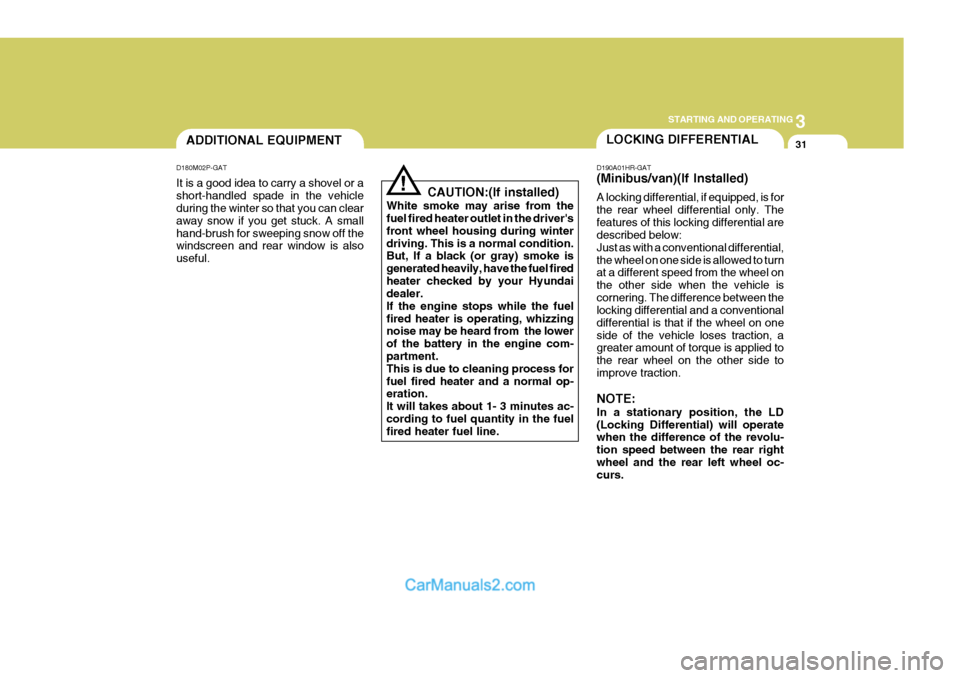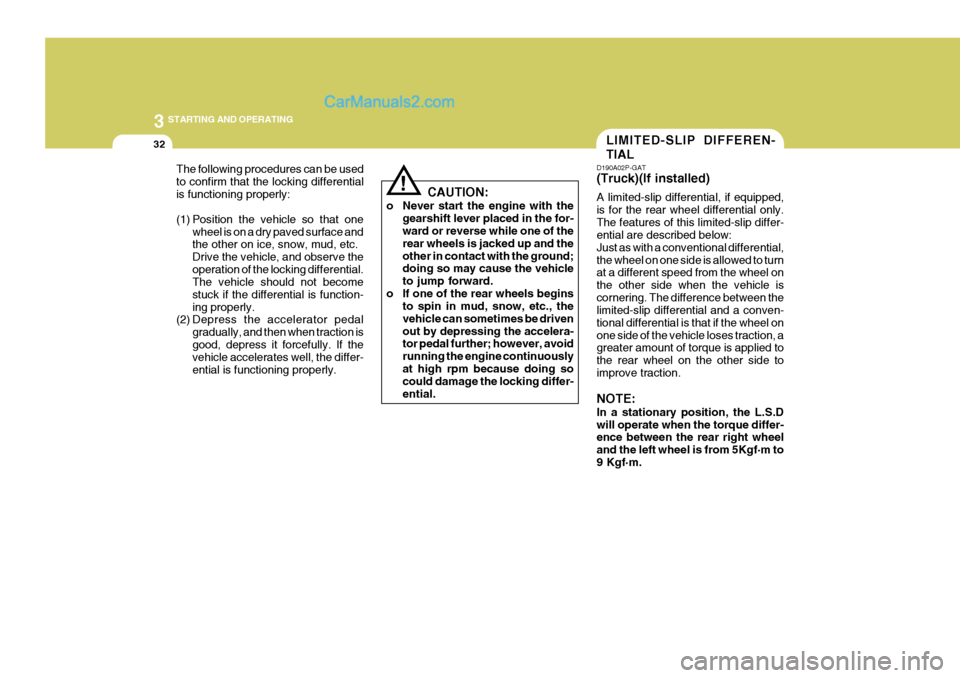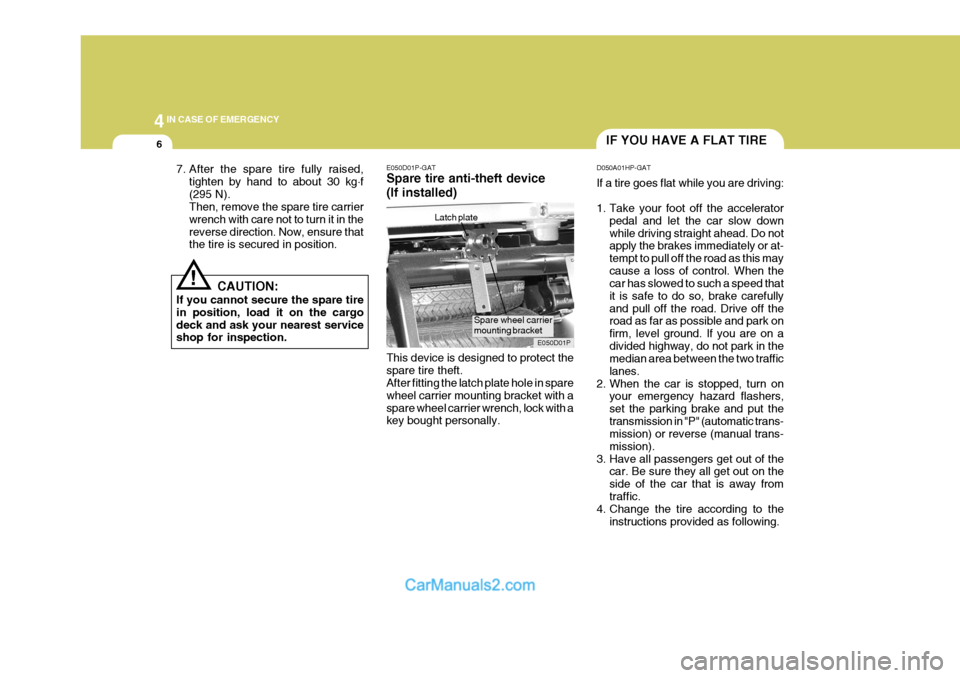Page 99 of 205

3
STARTING AND OPERATING
31LOCKING DIFFERENTIALADDITIONAL EQUIPMENT
D180M02P-GAT It is a good idea to carry a shovel or a short-handled spade in the vehicle during the winter so that you can clear away snow if you get stuck. A smallhand-brush for sweeping snow off the windscreen and rear window is also useful. D190A01HR-GAT (Minibus/van)(If Installed) A locking differential, if equipped, is for the rear wheel differential only. Thefeatures of this locking differential are described below: Just as with a conventional differential,the wheel on one side is allowed to turn at a different speed from the wheel on the other side when the vehicle iscornering. The difference between the locking differential and a conventional differential is that if the wheel on oneside of the vehicle loses traction, a greater amount of torque is applied to the rear wheel on the other side toimprove traction. NOTE: In a stationary position, the LD (Locking Differential) will operate when the difference of the revolu- tion speed between the rear rightwheel and the rear left wheel oc- curs.
CAUTION:(If installed)
White smoke may arise from thefuel fired heater outlet in the driver's front wheel housing during winterdriving. This is a normal condition. But, If a black (or gray) smoke is generated heavily, have the fuel firedheater checked by your Hyundai dealer. If the engine stops while the fuelfired heater is operating, whizzing noise may be heard from the lower of the battery in the engine com- partment. This is due to cleaning process forfuel fired heater and a normal op- eration. It will takes about 1- 3 minutes ac-cording to fuel quantity in the fuel fired heater fuel line.
!
Page 100 of 205

3 STARTING AND OPERATING
32LIMITED-SLIP DIFFEREN- TIAL
CAUTION:
o Never start the engine with the gearshift lever placed in the for- ward or reverse while one of the rear wheels is jacked up and theother in contact with the ground; doing so may cause the vehicle to jump forward.
o If one of the rear wheels begins to spin in mud, snow, etc., thevehicle can sometimes be drivenout by depressing the accelera- tor pedal further; however, avoid running the engine continuouslyat high rpm because doing so could damage the locking differ- ential.
!
The following procedures can be used to confirm that the locking differentialis functioning properly:
(1) Position the vehicle so that one
wheel is on a dry paved surface and the other on ice, snow, mud, etc. Drive the vehicle, and observe theoperation of the locking differential. The vehicle should not become stuck if the differential is function-ing properly.
(2) Depress the accelerator pedal
gradually, and then when traction isgood, depress it forcefully. If the vehicle accelerates well, the differ- ential is functioning properly. D190A02P-GAT (Truck)(If installed) A limited-slip differential, if equipped, is for the rear wheel differential only.The features of this limited-slip differ- ential are described below: Just as with a conventional differential,the wheel on one side is allowed to turn at a different speed from the wheel on the other side when the vehicle iscornering. The difference between the limited-slip differential and a conven- tional differential is that if the wheel onone side of the vehicle loses traction, a greater amount of torque is applied to the rear wheel on the other side toimprove traction. NOTE: In a stationary position, the L.S.D will operate when the torque differ- ence between the rear right wheel and the left wheel is from 5Kgf·m to9 Kgf·m.
Page 103 of 205
44IN CASE OF EMERGENCY
2
Release valve
TOOLS AND JACK
E010A01P-GAT To provide for cases of emergency, always remember where the tools and jack are stowed and how the jack is removed for use.
E010B03P-GAT Storage places E010C03P-GAT TOOLS
E020A01P-GATJACK To use the jack
The tool box is at the right rear corner of the luggage compartment (minibus/ van) or on the floor behind the seat(truck). Minibus/Van Truck
1. Tool case
2. Wheel nut wrench
3. Screwdriver
4. Spare wheel carrier wrench(Truck only) 4
Turn the knob clockwise, and then remove the lid. Remove the securing nut, and then take out the jack.
E010B01P-2 E010C03P
E020A01P
Minibus/Van Truck
Securing nut
Ram 1
2 3
Page 106 of 205
4
CORROSION PREVENTION AND APPEARANCE CARE
5
4
IN CASE OF EMERGENCY
5
E050C01P-GAT (Truck)
1. Connect the spare wheel carrier
wrench (1) with the wheel nut wrench (2).
2. Insert the spare wheel carrier wrench
into the hole in the spare tire carrierthen turn the wheel nut wrench coun- terclockwise, and the spare tire comes down. 3. Disconnect the steel wire (3) from
the tire support hook (4) after thespare tire comes down completely.
4. To install the spare tire, build the spare tire as following.
E050C01P
E050C02P
5. Connect the steel wire (3) with thesupport hook (4).
6. Insert the spare wheel carrier wrench into the hole in the spare tire carrier then turn the wheel nut wrench clock- wise. HHR4026
E050C03P E050C05P
Rear wheel tire
Wheel carrier guide
Front wheel tire Tire support
(1)
(2)
(3)
(4)
(3)
(4)
Page 107 of 205

44IN CASE OF EMERGENCY
6IF YOU HAVE A FLAT TIRE
7. After the spare tire fully raised, tighten by hand to about 30 kg .
f
(295 N). Then, remove the spare tire carrier wrench with care not to turn it in thereverse direction. Now, ensure that the tire is secured in position.
CAUTION:
If you cannot secure the spare tire in position, load it on the cargodeck and ask your nearest service shop for inspection.
! E050D01P-GAT Spare tire anti-theft device (If installed) This device is designed to protect the spare tire theft. After fitting the latch plate hole in spare wheel carrier mounting bracket with aspare wheel carrier wrench, lock with a key bought personally.Latch plate
E050D01PD050A01HP-GAT If a tire goes flat while you are driving:
1. Take your foot off the accelerator
pedal and let the car slow down while driving straight ahead. Do not apply the brakes immediately or at- tempt to pull off the road as this maycause a loss of control. When the car has slowed to such a speed that it is safe to do so, brake carefullyand pull off the road. Drive off the road as far as possible and park on firm, level ground. If you are on adivided highway, do not park in the median area between the two traffic lanes.
2. When the car is stopped, turn on your emergency hazard flashers,set the parking brake and put thetransmission in "P" (automatic trans- mission) or reverse (manual trans- mission).
3. Have all passengers get out of the car. Be sure they all get out on theside of the car that is away fromtraffic.
4. Change the tire according to the
instructions provided as following.
Spare wheel carrier mounting bracket
Page 108 of 205
4
CORROSION PREVENTION AND APPEARANCE CARE
7
4
IN CASE OF EMERGENCY
7CHANGING A FLAT TIRE
D060A01HP-GAT The procedure described on the fol- lowing pages can be used to rotatetires as well as to change a flat tire. When preparing to change a flat tire, check to be sure the gear selectorlever is in "P" (automatic transmission) or reverse gear (manual transmission) and that the parking brake is set, then: HSRFL060D060A01P-GAT 1. Obtain Spare Tire and Tool
E010B01P-3
HSRFL050
Remove the spare tire and take out the jack and tool bag. D060C01A-AAT 2. Block the Wheel Block the wheel that is diagonally op- posite from the flat tire to keep the vehicle from rolling when the car israised on the jack.
HA14009
NOTE: The spare tire is located underneath the car.
Flat tire
Minibus/Van Truck
Page 109 of 205

44IN CASE OF EMERGENCY
8
D060D01A-AAT 3. Loosen Wheel Nuts The wheel nuts should be loosened slightly before raising the car. To loosenthe nuts, turn the wrench handle coun- terclockwise. When doing this, be sure that the socket is seated completelyover the nut so it cannot slip off. For maximum leverage, position the wrench so the handle is to the right asshown in the illustration. Then, while holding the wrench near the end of the handle, pull up on it with steady pres-sure. Do not remove the nuts at this time. Just loosen them about one-half turn. HSRFL056
D060E01P-AAT 4. Put the Jack in Place
Rear
E040A03P
HSRFL040
HSRFL042
2WD Front
4WD Front
The method for jacking up the vehicle should be remembered in order tochange a tire in the event of a puncture and in order to install tire chains. After stopping the engine and applying the parking brake on a flat level sur-face, also use chocks to hold the wheels. Position the jack only at the specified points indicated in the illustration, and the use of the jack at other points coulddamage the vehicle body.
Page 110 of 205

4
CORROSION PREVENTION AND APPEARANCE CARE
9
4
IN CASE OF EMERGENCY
9
D060F02P-GAT 5. Raising the Car Open the lid at the right corner of the luggage compartment (minibus/van)or on the floor behind the seat (truck). Loosen the securing nut, and then take out the jack. Using the jack handle, turn the releasevalve clockwise until it reaches a stop.
HAUT408
HAUT405
E020A01P
Move the jack handle up and down to raise the ram until just before the jack contacts the jacking point of the car.Position the jack with the jack handle. Position it only at the specified points indicated in the "Put the Jack in Place".Use of the jack at other points could damage the car. Moving the jack handle up and down toraise the ram. As the jack begins to raise the vehicle, double check that it is properly posi-tioned and will not slip.
Then fit the jack handle into the holder,and align the groove of the jack handle with the notch of the holder.
Minibus/Van Truck
HAUT406RamPressure piston
Jack handle
Notch of holder